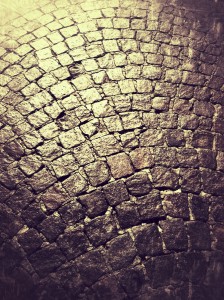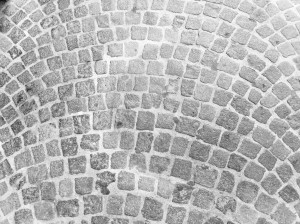Position, Measurement and Observation (Part 2)
By Asher Crispe: August 20, 2013: Category Inspirations, Quilt of Translations
Prologue to a Theory of Law
 The ultimate manifestation of judgement does not ‘take things sitting down.’ As we mentioned previously, our verse (Habakkuk 3:6) begins by relating a mode of infinite judgement figured as God ‘standing.’ And what does He do from this expanded state of self-expression? He “measures out the earth.” But why? Have we not learned in the opening of the Genesis narrative that God created the heavens and the earth? Certainly the Creator has to know the dimensions of the earth which He Himself created? Moreover, if the earth requires measuring, would that not presume a limitation to Divine omniscience?
The ultimate manifestation of judgement does not ‘take things sitting down.’ As we mentioned previously, our verse (Habakkuk 3:6) begins by relating a mode of infinite judgement figured as God ‘standing.’ And what does He do from this expanded state of self-expression? He “measures out the earth.” But why? Have we not learned in the opening of the Genesis narrative that God created the heavens and the earth? Certainly the Creator has to know the dimensions of the earth which He Himself created? Moreover, if the earth requires measuring, would that not presume a limitation to Divine omniscience?
All of this is completely counter intuitive to how we think of the earth. Is not the earth— especially in contrast to the heavens—a symbol of solidity, concreteness, fixture and foundation? Bringing abstract ideas down to earth would reportedly materialize them by ferrying them from amorphous potential to chiseled actuality. Sometimes we associate the heavens with a transcendent subjective sphere while the earth acts as the general sign for the objective, immanent domain. Being that it’s supposed to represent an empirically testable space ‘out there’ how could the earth play games with its own proportions?
With the exception to the psychotropically induced and inducing journey down the rabbit hole with Alice in Wonderland, our hardware stores don’t keep tape measures of modulating length in stock. One would hope that my meter stick will always be in agreement with yours. Since feet are no longer contingent on a monarch of flesh and blood’s shoe size, we imagine and place our perceptual faith in the accuracy of the measuring device and the reality being measured. After all, the earth convincingly passes itself off like a constant—an invariant framework that encloses all of our activities and holds forth the promise of reconciling agreements over the true nature (and proportion) of just about everything.
Never short on substitute terminology which can be affixed to ordinary words and concepts in the Torah, the tradition of Jewish esotericism often cites the earth as a term for the whole of reality (mitziut). Heaven would then operate like an ephemeral nether region populated by abstract essences, while the earth certifies the real (which may or may not correspond to the ‘essential’ or ‘ideal’ above). This introduces a tongue twister coupled with a mind pretzel: if the real is really real then the Creator that realized that reality should already be familiar with it. Furthermore, we find that the Torah maintains that there is no other, no external reality other that the Divine, so it would follow that He knows everything by knowing Himself. Given this line of reasoning, it would give weight to the notion that all measurements are ‘pre-given,’ and that we witness Divine measurement from our perspective as finite creatures, which generates the illusion that God is measuring when this superfluous exercise is only for our benefit. It’s all part of the act.
Every time the world goes through the convulsions and gyrates, it is a signal to us that some Divinely enacted measurement is taking place. This can also be recovered from our verse which uses the word vayimoded ‘and he measured’ which can also be translated as ‘and He shakes the earth’ (following the Targum [Aramaic translation] which renders it as v’azea) in that measurement not only disturbs what is being measured (consider a situation where the only way to tell the age of a tree necessitates chopping it down in order to count the tree rings) but also ‘shakes things up.’ The firm and fixed aspects of the earth as ‘reality’ break loose from their moorings. The measurement that fueled our judgements and which gave credence to the illusion of solidity also dispels that illusion.
Following the commentary of Rashi in this verse, we need to make sense of his attaching of this ‘measurement as an act of terraforming’ to the generation of the flood in the Noah narrative. In Kabbalah, each distinct generation mentioned in the Torah is paradigmatic of a universal trait in the soul. Each generation may be likened to either a phrase that we pass through spiritually or a strata of psychological experience that gets recycled continuously through our lives. Without delving into the particulars, we might summarize the generation of the flood as a time when people were behaving in an unbridled sexual manner.
Exegetes sometimes assert that it was a time of hyper sexuality. Mystically speaking, knowledge (as in ‘Adam knew his wife Eve’—the euphemism for sexual relations) is a creative connection between subject and object. With the formulation of ‘sex as knowledge’ as well as its reverse—’knowledge as sex,’ the pan-sexual drive of the generation of the flood more or less wanted to interconnect everything with all reproductive informational links contributing to ‘flooding’ the world with knowledge. The result was to cover the world with that layer of information which not only concealed the firm earth but reshaped it. When every aspect of our reality is connecting together and exhibiting a free exchange of signs (signs which float as in free floating signifiers—for is not sexual exchange really distillable to a bioinformatic transfer?) which reprogram the terrain.
Notwithstanding the potential up side of this endeavor, the side effect was to blur the topography of reality to the point where it collapsed back into one undifferentiated fluid mass. Overwhelmed by the over abundant connections (this certainly applies to the mind’s mental landscapes) we lose slight of all fixed objects with which we anchor ourselves and our operating distinctions about the nature of the world. When things finally dry out and the water recedes, it is as though some sensibility has been returned to us, albeit with a new orientation on a new map. Infinite judgements wipe out the old while making room for the new.
Returning back to the issues of ‘standing’ (supernatural) verse sitting (natural) in our Divine posturing, we may reconcile our common-sense understanding of the earth being of a certain measurement prior to measuring it with this new notion of measurement jarring reality and then placing the finishing touches on what was before, at best, half-baked. Objective reality is preserved as long as we are dealing with a ‘seated’ ontology, where the Divine remains camouflaged within the natural scheme of things. However, once we broaden our scope of inquiry and admit the possibility of something which transcends nature, then the uncertain foundation of reality begins to protrude. Not only is the earth not flat, it’s not solid either. This is the conceptual dynamite which quantum physics used to blow up our lasting attachment to a fixed world given over to us unadulterated by the process of measurement.
Seated reality would then correspond to classical physics (as well as judgements of fact) while that which stands over reality catapults us into the realm of metaphysical inquiry, reminding us the the earth is mostly water—which is to say that the real is never that real. It needs to be made real. Reality as a project in the making assumes that each measuring opportunity enacts a redistribution of the properties of the earth. Whether volcanic or tectonic, glacial or with sudden meteoritic impact, the metamorphoses of the earth tells tale of the revisable objective world.
 If God is continually recreating the world at each and every moment, then part of that grand artistry entails taking new measurements. Then, even the old and consistent, despite the close resemblance, must be taken as new on some level. Every metering out of existence is a shake up. Considering this from the angle of infinite judgements drives home the idea that the case at hand (this is certainly true with regard of legal cases) may always be an ‘open case,’ that is, it remains fundamentally incomplete, ambiguous and indeterminate until such time as the ‘facts as raw materials’ are measured and weighed and issued a summary judgement (perhaps all judgements are ‘summary judgements’). Passing through the test of measurement casts the loose soil of undefined reality through the funnel of finition, causing it to clump together in ever fascinating new forms so that we may build upon it.
If God is continually recreating the world at each and every moment, then part of that grand artistry entails taking new measurements. Then, even the old and consistent, despite the close resemblance, must be taken as new on some level. Every metering out of existence is a shake up. Considering this from the angle of infinite judgements drives home the idea that the case at hand (this is certainly true with regard of legal cases) may always be an ‘open case,’ that is, it remains fundamentally incomplete, ambiguous and indeterminate until such time as the ‘facts as raw materials’ are measured and weighed and issued a summary judgement (perhaps all judgements are ‘summary judgements’). Passing through the test of measurement casts the loose soil of undefined reality through the funnel of finition, causing it to clump together in ever fascinating new forms so that we may build upon it.
The power to measure the earth (which in our present example uproots all of the marked features in the map of reality rather than merely confirming them) compels the most trusted cartographer to constantly revisit the places of past familiarity. Consequently any case presented to us must be turned over and over again in the mind wary of the earthquake that measurement can cause.
The earth is filled with both natural and artificial boundaries and so is reality. Charting a course through the real often focuses on the historical setting of places and people, of social and political configurations of the land. These too may have a pretense of permanence but, as we hope to demonstrate in Part Three, they are just as prone to redistribution.
http://www.interinclusion.org/inspirations/position-measurement-and-observation-part-1/
http://www.interinclusion.org/inspirations/position-measurement-and-observation-part-3/
Position, Measurement and Observation (Part 2),


















;)
;)
;)
;)
;)
;)
;)
;)
;)
;)
